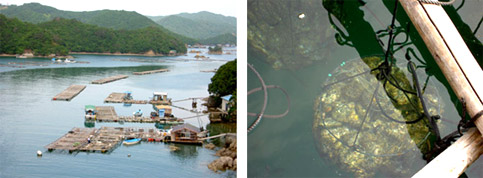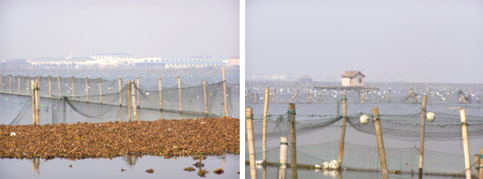|
Nowadays, when people learned how to grow cultured pearls, pearl jewelry became widely available. It is amazing, how a pearl is developed. Opposed to precious stones and metals, mined from the deep under ground, pearls develop in oysters, which live in salt- and freshwater. Precious stones need to be polished and burnished, so that they would become gems. Pearls do not need such special treatment, as their beauty is nature’s creation itself.
Pearls developed in oysters are perfect, nature given gemstones with smooth shiny and heating surface, sparkling in sunlight with all colours of the rainbow, dissimilar from all other jewelry. Pearls, in fact, are foreign bodies, similar to parasites, living in soft tissues of oysters.

The oyster itself is unable to expel the outside object, yet its organism is constantly fighting with the inner irritator by secreting crystalline substance to surround the object to neutralize the activity of a parasite. This substance is called the nacre. The longer the pearls stays inside the oyster, the thicker the nacre will be. In such a way a beautiful and shiny gemstone is produced. The nacre consists of microcrystals of calcium carbonate, ranged in line one after another, so that the sunbeam, incident on one crystal is reflected in another at once, causing a rainbow effect. Cultured pearl has the same characteristics as the natural one. The bead inside an oyster develops in the same general shape as the original bead, the same way, as it would happen without human interference, which lies in a careful operation only during the pearl development stage.
Further on, according to nature’s rules, the miracle, known as the pearl, is created by an oyster itself. Pearl cultivation affords certain opportunities for selection, yet, however, the results will in many respects depend not on human desires, but on the laws of nature, developed for thousands of years, thanks to which the counteraction of an oyster with the external object results in pearl nucleation. Japanese scientists, engaged with cultured pearls selection, developed the most reproductive kinds of oysters. This selection enabled them to cultivate pearls with unique luster and color intensity.
Cultivation process, developed by Japanese scientists, starts with the moment, when the shell is cautiously opened and a small incision to the gonad is made. Simultaneously a small piece of mantle tissue from a donor mollusk is taken to join it with the nucleus of the future pearl. The epithelial cells of the taken piece of tissue with form the pearl sac. The pearl sac then grows around the nucleus and begins to deposit nacre. Then, the future pearl is implanted into the first oyster, which is then taken to its natural habitat – the sea, full of nourishment, required for the oyster for healthy growth. Throughout this process it is extremely important to control water temperature, in which the oysters are being grown. Besides, mollusks have to be cleaned and examined from time to time.
Thus, for example, some kinds of larvae and crustaceans constitute threat for oyster’s health, which is why they have to be removed from the surface of shells and cleaned with special medical solution, preventing the parasite spread. The process of pearl nucleation lasts for several years, while all these procedures have to be regularly performed, which is only after then, finally, the objective of all this work and time spend, a fine and valuable pearl, is extracted.
The abruptness and petulance of natural environment prevents from making pearl cultivation a mass production. Every year millions of oysters are being selected for pearl cultivation, yet only a few of them are able to produce high-quality pearls. Many of them will die; some will loose their production capacity due to illness. Heavy rain showers, which reduce saltiness of seawater, some kinds of phytoplankton, whose population growth reduces oxygen content of water, typhoons, attacks of predators and parasites, lack of nourishment – all these factors prevent from marine mollusks population growth. On the average, only 50% of all oysters selected will produce pearls, while only one-fifth of these pearls are marketable. The other pearls left are usually too damaged to use in jewelry. In return, high-quality pearls are very rare gifts of nature: according to statistics, less than 5% of the whole amount of cultivated pearls is of regular shape and distinctive bright luster. These pearls are true treasures, a real catch for any jewelry collection. Pearls collected have to be selected.
There are no two identical pearls in nature, which is why pearl selection is extremely difficult and time-consuming process. Pearls are being classified by their size, shape, colour and brightness of nacre, which is why each gem can be moved from place to place for several times. After selection has been accomplished, a hole is carefully drilled in every pearl, so that no damage would occur. Besides, it is extremely important for the hole to be strictly on centre of the pearl, as even slight asymmetry can damage the way how pearl jewelry looks.
The next stage is pearl matching for a jewel. This is even more laborious procedure, than the selection: the jewelers have to select the most resembling pairs of gems from every group of pearls, classified by their size, shape, colour and brightness, which means that these pearls are very much alike to each other. Only very experienced specialist can match pearls for a necklace, ear-rings or other jewels in a high-skilled manner. Thus, for example, to select 47 perfectly matching pearls for a 42 cm necklace, one has sometimes to look through more than 1 000 gems.
A bit of history…
Already in XIII century the Chinese discovered that the foreign objects get covered with nacre, when put into freshwater mollusk shells. They used a special separator to open the valves and inserted then the bead between the pallium and the valve of a mollusk with a special bamboo stick. After that the shell was returned to its natural habitat and left for several months or even two or three years. At this distance of time the bead was covered by nacre and grew to the shell. The beads could be clay balls, pieces of bone, wood or copper. Often the diminutive statuettes of Buddha, made of lead or tin, were put inside the shell. This art flourished for seven centuries in China. In XVIII c. approximately this way was independently proposed by Sweden naturalist Linnaeus, and nowadays some of his cultivated pearls are in collection of the Linnean Society of London. Linnaeus did not improve his method himself, but he revealed its secret in 1762. Supposedly, his method was to drew a hole in a valve and then to implant a limestone bead with a silver wire. The wire enabled to move the bead from time to time, so it would not grow to the shell. This method was not wide spread and was soon forgotten.
At the end of the last century the Japanese adopted the Chinese long-lasting art of pearl cultivation and, approximately in 1890 established their own branch of industry. The Japanese method is to attach a pearl bead to the mother-of-pearl and to return the shell back to the sea. This method enabled to produce formations, similar to blister pearl. The deposition velocity varies, but, apparently, is considerably higher, than when a mollusk is disturbed. The nacre covered the beads from one side only, so, when extracted from the shell, they had to be attached to an external piece of nacre to give them regular shape. That is why “the Japanese” pearls, as they were called since, are easily recognized, when their reverse side is examined.
Numerous experiments, carried out in 1914 by Mikimoto mainly, enabled to improve the method; the product is now known as the “cultured pearls”.
The first cultured pearls appeared on the London market in 1921. People decided they originated from a new pearl bed. As soon as the pearl nuclei were discovered inside the pearls, the pearl dealers became scared to death. Soon however was discovered that in ultraviolet light they fluoresce virescent, which enabled to distinguish them from the natural ones, which fluoresce with sky-blue colour. According to the latest research, this difference in fluorescence is determined by different water types, which were the natural habitats of the corresponding pearl oysters, but not by the way the nacre is secreted, so this test is not quite reliable to determine the cultured pearls. Fortunately, shortly before this discovery, the other method was proposed and now the experienced specialist can determine without any mistake, was this pearl developed with or without human interference. As a result, prices for pearls reduced rapidly to one-half of the usual ones for the natural pearls, and afterwards - to one-fifth or even less. The point at issue is how long this difference in prices for natural and cultured pearls will exist. As for many other articles of luxury, prices for pearls are determined only by the fact how much money is the customer ready to pay for them, while the experts insist that the natural pearls would be more expensive than the cultured ones. This point of view seems to be absurd, as the thickness of nacre of both of the types is identical, at least so far as the human eye can detect it.
During the WWII in Japan pearl cultivation was practically suspended due to lack of labour and difficulties, concerned with materials and equipment acquisition. Besides, shortage of food supplement led to consumption of oysters for food. It took a long time to revive this field of industry, but by 1952 the value of cultured pearl exports from Japan reached approximately 1 750 000 pounds sterling.
Chinese cultured pearls
Nowadays industrial cultivation of pearls is one of the most dynamically developing branches of Chinese economy.
The Chinese region Dejing, redundant with freshwater, is the major source of national pearl cultivation industry. Passing by the local lakes, one can see from a distance hundreds of white spots, hanging over the surface of water. These would be the fishing nets, full of pearl shells, carefully attached to bamboo sticks.

The “harvest” is collected in September in pearl farms, so at present time the workers have to be definite about the safety of shells. Any infection got into the pearl lagoon, could lead to epidemic, which could destroy the fruits of more than three-year labour.
Nowadays China is the largest freshwater pearl manufacturer. Each year this country produces almost 1000 tons of pearls, while there are more than 300 000 people working in local “pearl” industry.
The earliest pearl cultivation in China occurred in 13th century. However, strange though it may appear, more or less enabling technologies of industrial cultivation of pearl-producing shells in this country were worked out only by 1960-s. By the time the quality of Chinese freshwater pearls was unsatisfactory. Due to their irregular shape and unstable size, these pearls, known as the “rice pearls”, could not compete with homogenous round Japanese pearls of higher quality.
However, ever since the Chinese manufacturers did a break through by learning to cultivate large round pearls with wide range of sizes and colours. The local manufacturers managed to achieve much success also in further pearl processing. In the recent past Chinese pearl farm production was sent to factories in Hong-Kong and Japan. Today Chinese pearl processing is under total control of local companies, which have almost unrestricted resources of highly qualified and inexpensive labour.
At the factory the pearls are classified by their colour, shape and size. Strange as it may seem, only 10% of Chinese pearls are being used in jewelry industry. The rest of pearls are pulverized and is used in cosmetic industry and to prepare traditional Chinese healthcare products. Pearl powder, in particular, is included as a compound of facial cream, which is extremely popular among Chinese women, who consider paleness to be the characteristics of a true beauty.
|
